How to Spray Paint Indoors
Learn how to spray paint indoors without making a mess! Use these simple tips to spray furniture and DIY projects inside without getting paint everywhere!
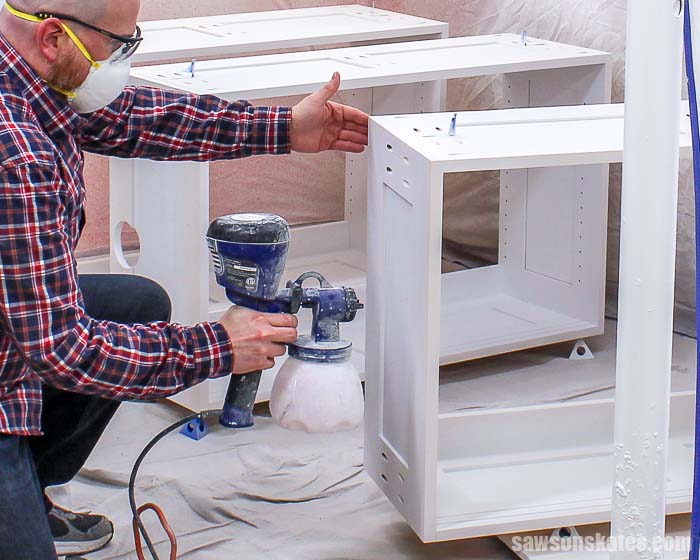
How to Spray Paint Indoors
Have you ever wanted to spray paint furniture in your house, apartment or basement but were afraid of making a big mess? What if I told you that you could use your HVLP sprayer indoors without getting paint everywhere? You would think I was crazy, right? Well, you can. Using a paint sprayer indoors is possible, and you can do it without making a mess. I’ll show you how!
This article contains affiliate links. If you purchase from these links, I may earn a small commission at no additional cost to you. Visit my site policies for more information.
I’m in the homestretch of building some tool storage cabinets for my small workshop. First, I used a shelf pin jig to add some adjustable shelves to the cabinets. Then, I built some Shaker cabinet doors to match the other doors I built for my workshop. All that was left was to paint the cabinets and get them hung on the wall.
Priming and painting three cabinets and six doors with a brush would have taken me forever, so instead, I wanted to spray them with my paint sprayer. Painting projects with a paint sprayer is quick and easy. Plus, there are no brush marks so the paint has a smooth factory-like finish.
Before we get into how to spray paint indoors without making a mess, be sure to click the subscribe button at the bottom of this page to sign up for my FREE weekly newsletter loaded with helpful pocket hole tricks, space-saving workshop ideas, clever DIY tips and more!
What to Do When Painting Outdoors Isn’t an Option?
I like to spray paint my furniture and DIY projects outside, but when my shop cabinets were ready for paint it was about 20 degrees and my yard was covered in snow! I needed to get these cabinets installed so I could start organizing my workshop which meant I was going to have to spray them indoors.
Warmer weather doesn’t always mean you can paint outside either. Rain and wind can ruin a project pretty quick.
Sometimes you just need to get the job done so you have to use your paint sprayer indoors. But there’s something you need to think about when you spray indoors and that’s overspray.
What is Paint Overspray?
When using your paint sprayer, there will always be a little overspray. Overspray is paint that sprays past your project and lands on surrounding objects. Overspray can be messy and it can be difficult to remove.
Paint overspray is something you need to think about if you’re using your paint sprayer outdoors or indoors. If you’re spraying outside, the overspray can land on houses and cars. And it can drift pretty far if there’s a breeze. If you’re spraying inside, the overspray can land on walls, floors, furniture, and more.
Can I Spray Paint in my House, Basement, Apartment or Garage?
Yes! You can absolutely use your paint sprayer inside your house, basement, apartment, or garage. You just need to do a little planning before you paint.
You’ll need to find an indoor location where you can spray, properly adjust your sprayer, and protect any surrounding objects from possible overspray.
How to Spray Paint Indoors Without it Getting Everywhere
- Choose Your Location
- Adjust Your Sprayer to Reduce Overspray
- Prevent Paint from Getting Everywhere with a Spray Shelter
- Protect Floors and Surrounding Objects with Drop Cloths
- Use a Paint Turntable
Step 1. Where Should I Spray Paint Indoors?
The first thing you’ll need to do is choose where you’re going to spray paint. You’ll need a location where you can lay out the pieces you’ll be spraying. And it’s always a good idea to choose a location that’s well ventilated.
For me, that location is my small workshop. Let me show you how I transform my small, mobile workshop into a place where I can spray paint furniture and DIY projects. I’m hoping it will inspire you to think of a location where you can use a sprayer at your place.
Related: My 12×13 Small Woodshop Layout
The first thing I do when I need to use my sprayer indoors is clear some floor space. I start by folding and removing my workbench. Then, I roll my table saw out of the way. This leaves me with plenty of floor space to set up for spraying my projects.
Related: How to Make a Folding Workbench
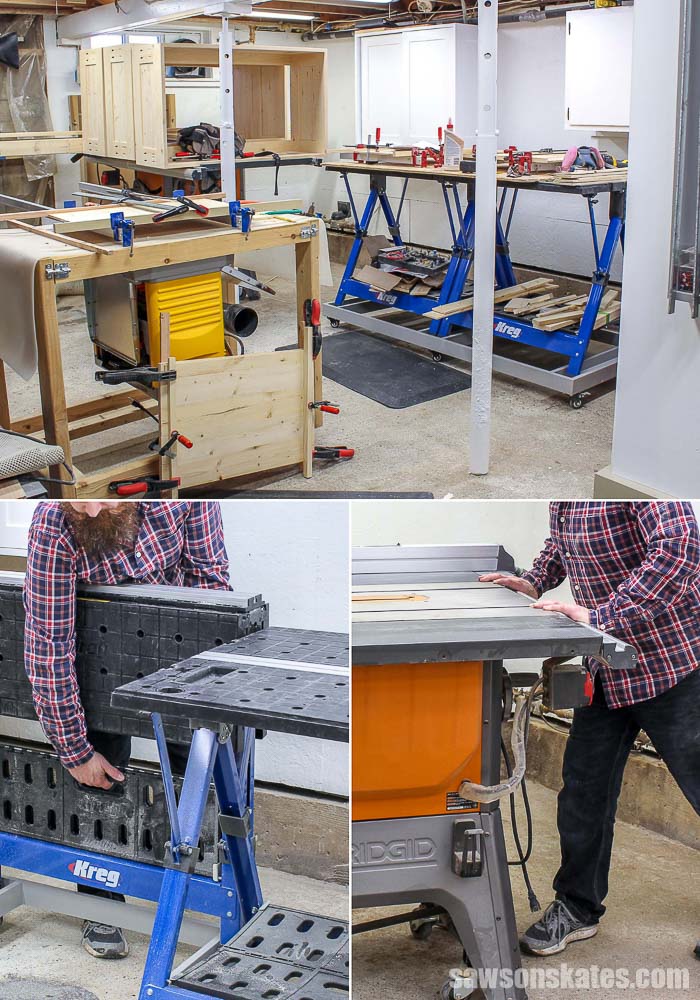
Step 2. Adjust Your Sprayer to Reduce Overspray
My go-to paint sprayer is my HVLP HomeRight Super Finish Max. It’s easy to use, easy to clean and it’s been a huge timesaver for me.
For some expert advice about spraying indoors with the Super Finish Max, I turned to my friends Laura and Makayla at HomeRight.
Makayla’s biggest suggestion for us is to “dial in your paint sprayer.” She said this will “help reduce overspray and ensure you aren’t outputting too much paint.” She went on to say “the Super Finish Max doesn’t produce a lot of overspray, to begin with, unlike other sprayers which might leave you with a big mess.”
A while back Laura and Makayla also gave me some great tips to avoid an orange peel texture when using a paint sprayer. Orange peel is the bumpy texture that can sometimes appear on the surface of our projects when using a sprayer. Outputting too much paint can cause overspray and it can create an orange peel texture.
Related: 7 Ways to Prevent Orange Peel Texture
💡 TIP: To avoid applying too much paint Makayla says “A quick adjustment of the volume control knob will work wonders!”
How do you know if you’re applying too much paint? Skate over to 7 Ways to Prevent Orange Peel Texture, and I’ll share with you how much paint you want to apply and how to adjust the sprayer so you’re outputting the right amount of paint.
Step 3. Use a Spray Shelter to Avoid a Big Mess
One of the best ways you can control overspray and avoid making a big mess is with a paint overspray shield or spray shelter. A spray shelter lets you paint your projects year round no matter what the weather is outside. And it means you can spray indoors without paint getting everywhere.
The spray shelter can also be used outdoors when the weather is good. Using the shelter outside protects surrounding objects like homes and cars from overspray. And it prevents dust and debris from landing on your project while it’s drying.
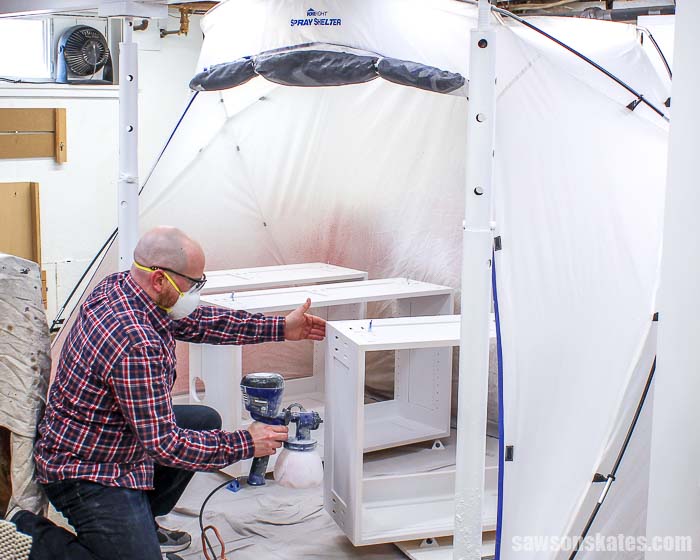
If you’ve ever gone camping in a dome tent, you’ll be familiar with the construction of the large spray shelter. There are two shock-corded poles that attach to the shelter with clips. All you have to do is lay the shelter on the floor and insert the poles. It’s a quick and easy way to protect your walls from getting messy with paint.
Spray shelters are available in several sizes depending on the size of our projects. For spraying my workshop cabinets I used the large spray shelter. For spraying Shaker cabinet doors I used the medium spray shelter.
Step 4. Drop Cloths Protect From Overspray
A tarp or drop cloth protects your floors from overspray. In the past, I’ve used a plastic tarp to protect the floor, but recently I switched to a canvas drop cloth.
The plastic tarp got a little messy after a few paint projects. The dried paint chipped off of the tarp as I folded it for storage. Then those paint chips would blow onto my project the next time I used the sprayer.
I’ve found paint doesn’t chip off of the canvas drop cloth. Plus, I can clean it in my washing machine. (I can’t be the only one who washes their drop cloths, right?!)
I also drape canvas drop cloths over any objects in the front of the spray shelter. Sometimes, a project is too large to move, and I may need to aim the sprayer towards the front of the shelter, which means there will be some overspray. The drop cloths will project those objects.
Step 5. Use a Paint Turntable
A paint turntable is like a lazy susan for your paint projects. The turntable allows you to spin your project so you can reach all surfaces with your paint sprayer. And it allows you to always aim the sprayer into the spray shelter, which prevents getting paint from landing on surrounding objects.
Related: How to Make a Spray Paint Turntable
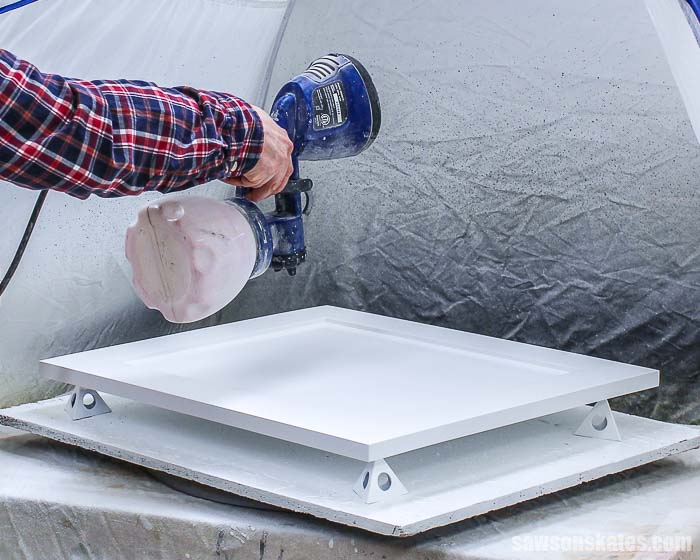
How to Get a Smooth as Glass Paint Finish
We all want our spray painted furniture and DIY projects to be as smooth as glass right?! Skate over to 7 Ways to Prevent an Orange Peel for simple tips to get a smooth paint finish.
Final Thoughts
Using a paint sprayer indoors doesn’t have to be messy. First, choose a well ventilated indoor location. Properly adjust your sprayer. Outputting too much paint can produce overspray. Use a spray shelter to prevent paint from getting everywhere. Protect surrounding objects with drop cloths. Use a paint turntable to be sure you’re always spraying into the spray shelter.
Thank you for stopping by. If you found this information helpful, would you please pin it to Pinterest? Other DIYers would appreciate it and I would too! Thank you – Scott

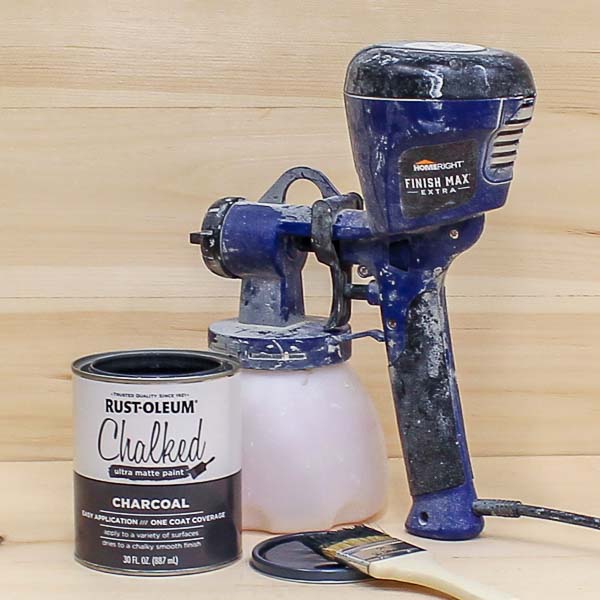
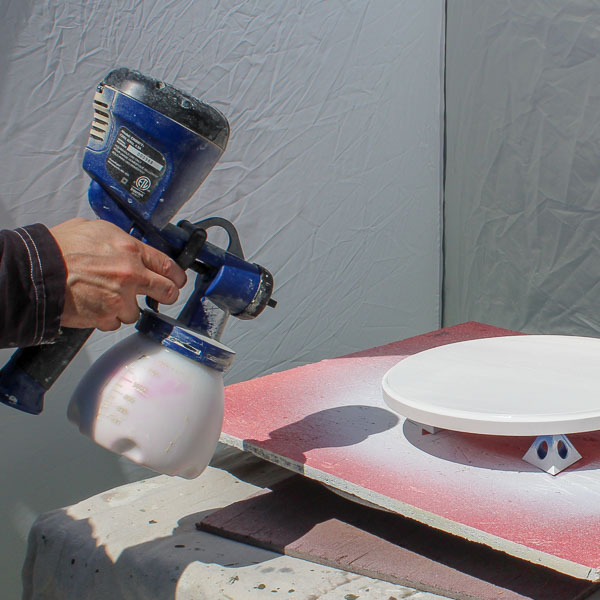
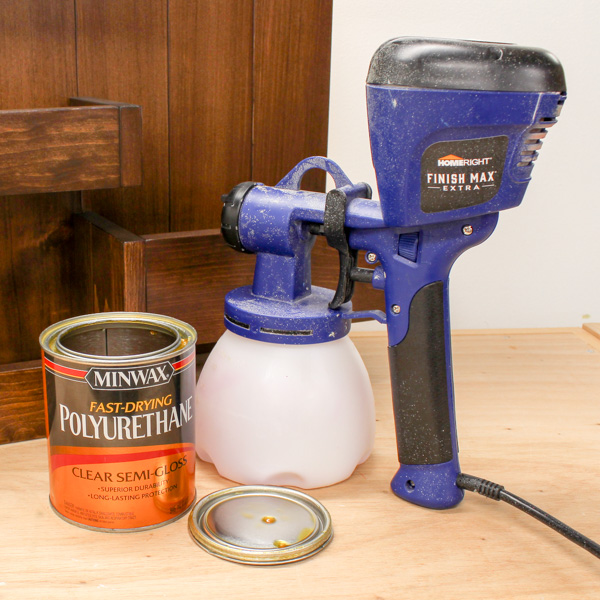
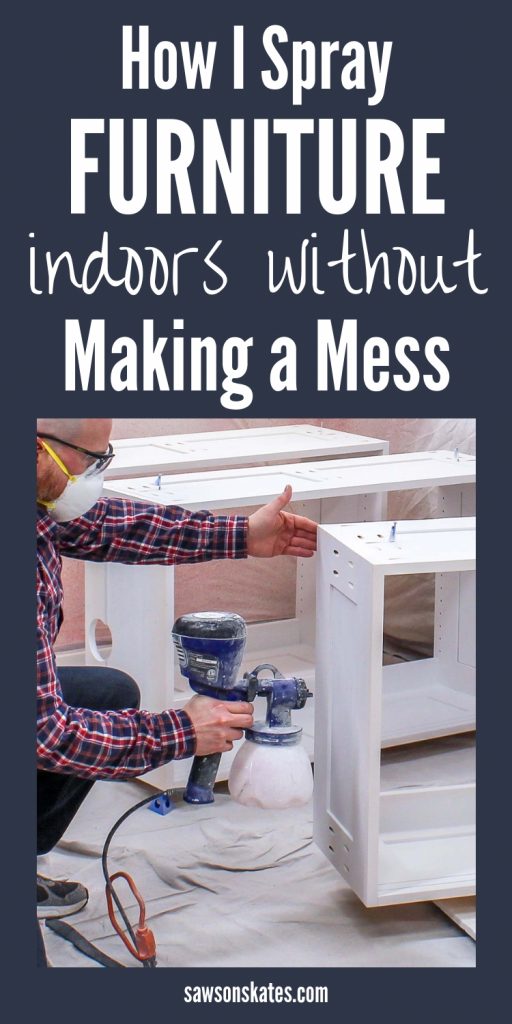
Very awesome videos. I am planning to make cabinets for my kitchen and your videos have inspired me to proceed with my plans – which i was having second thoughts about when first researching how-to videos.
Yours are easy to follow and detailed step by step without leaving the viewer with any guess work. Great job and thanks!
I have signed up to your emails and look forward to receiving them as they are all great information, right to my inbox!
Hi Paul – Thank you for stopping by and for the compliments. Good luck with your kitchen cabinets!